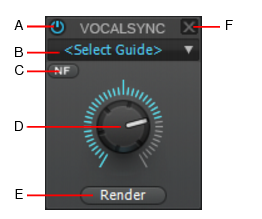The VocalSync editor can be opened for any VocalSync Region FX clip. For details, see To specify the dub audio and To open the VocalSync editor.Figure 493. VocalSync.Figure 494. VocalSync editor.A. Bypass B. Guide Track C. Show/hide Noise Filter Strength control D. Guide Strength E. Render F. Close editor







Tip - Searching Documentation
Tip: To search for a specific topic, type your search query in the Search Cakewalk.com field at the top right of this page.
When the search results appear, click which product's documentation you would like to search to filter the search results further.
Note - Using Offline Help
Note: If you prefer to always use offline Help, go to Edit > Preferences > File > Advanced in your Cakewalk software and select Always Use Offline Help.
If you are not connected to the internet, your Cakewalk software will default to showing offline help until an internet connection becomes available.





